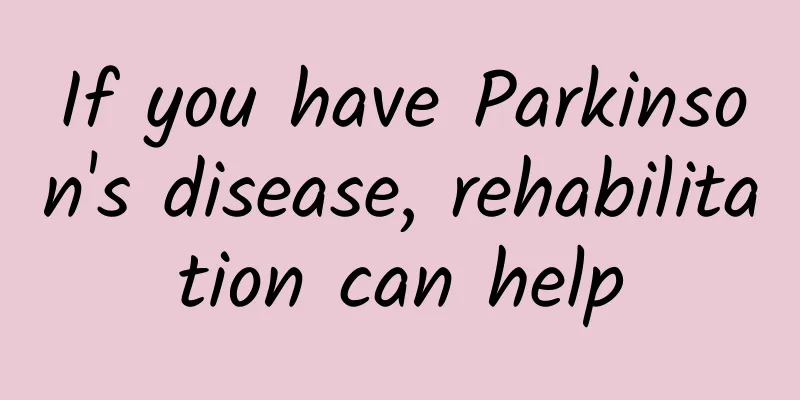If you have Parkinson's disease, rehabilitation can help

|
Parkinson's disease (PD) is a slowly progressive neurodegenerative disease that is common in middle-aged and elderly people, characterized by progressive degeneration of dopamine neurons in the substantia nigra of the midbrain and involving multiple systems. The main clinical manifestations are motor symptoms of bradykinesia, resting tremor, muscle rigidity, and postural gait disorders, as well as non-motor symptoms such as cognitive-emotional disorders, sleep disorders, abnormal bowel movements, pain, and fatigue. At present, drug therapy is still the basic treatment for Parkinson's disease and for controlling the progressive development of the disease. At the same time, combined with rehabilitation therapy, improving the patient's functional disorders is a necessary means to improve their ability to take care of themselves. So if you encounter Parkinson's disease, what can rehabilitation do? According to the "Parkinson's Rehabilitation Chinese Expert Consensus" published in 2018, the rehabilitation process of Parkinson's disease can be completed based on the World Health Organization's International Classification of Functioning, Disability and Health (ICF) framework. As we all know, the ICF classification system divides functional status into three dimensions, namely body function and structure, the ability of individuals to complete tasks or movements, and the ability to participate in family and social activities . The evaluation of Parkinson's patients, the selection and formulation of treatment goals and treatment plans should also be carried out step by step from these three aspects. First of all, the functional assessment of Parkinson's patients should be based on their different clinical symptoms. Doctors and therapists use appropriate scales or evaluation methods to conduct targeted and individualized assessments of motor symptoms and non-motor symptoms. Parkinson's patients usually have problems such as bradykinesia, muscle and joint stiffness, postural balance disorders, gait abnormalities, and difficulty in hand functional activities. At this time, physical therapists can use the MDS Unified-Parkinson Disease Rating Scale (MDS-UPDRS) to assess the corresponding problems. At the same time, based on the actual situation, the Berg balance scale and functional reach test are used to quantitatively evaluate the patient's balance and body stiffness . The six-minute walk test is used to understand the patient's exercise endurance and walking status , and a simple upper limb function test or a nine-hole column test of hand functional activities is selected. For secondary conditions such as decreased muscle strength caused by long-term reduction in exercise, manual muscle strength tests and joint range of motion measurements can be selected to understand the basic situation. In view of their speech disorders and decreased swallowing function , speech therapists can use the modified Frenchay dysarthria assessment method and the water drinking test to assess them respectively. In addition, what cannot be ignored is the non-motor function disorders of Parkinson's patients, including cognitive disorders, emotional disorders, sleep disorders, etc. Questionnaires such as the Mini-Mental State Examination (MMSE), the Parkinson's Disease Cognitive Rating Scale (PD-CRS), the Depression and Anxiety Scale, and the Sleep Quality Index can all be used. Combined with the assessment of daily living activities and understanding of the quality of life, we can fully understand the disease status of Parkinson's patients and carry out targeted therapeutic interventions. The goal of Parkinson's treatment must be to strengthen self-management and participation on the basis of drug treatment, to delay the progression of the disease to the maximum extent, to improve various functional disorders, to improve functional independence and overall adaptability, to minimize secondary disorders and various complications, to improve ADL, and ultimately to improve the quality of life of PD patients. After a comprehensive assessment, according to the assessment results, a scientific and comprehensive rehabilitation training plan is formulated for the obstacles found in limb function and social participation, so as to gradually improve the daily living ability and social participation function of Parkinson's patients and improve their quality of life. |
<<: What you don't know about congenital heart disease
>>: Let you understand the cross syndrome
Recommend
How to use enema after episiotomy
Everyone needs to correct their understanding of ...
How to treat female vaginitis?
Many women do not know how to treat vaginitis, be...
How to diagnose endometriosis
We can never avoid the occurrence of some disease...
What is the disease of hot soles of women's feet
Whether it is a man or a woman, human health is v...
What is the treatment for vulvar white spots?
The impact of vulvar leukoplakia on female friend...
Is women’s fear of cold due to kidney yin deficiency or kidney yang deficiency?
The kidney is one of the five internal organs in ...
What should I do if I can’t get pregnant?
In life, the inability to conceive is related to ...
What are the treatments for candidal vaginitis?
Vaginitis is a common disease among women. This t...
Why does the areola suddenly become larger?
Many women will find that their areola suddenly b...
What to eat during menstruation to lose weight
Losing weight is a topic we have to talk about. T...
Why do my hands hurt during confinement?
In China, confinement after childbirth is a very ...
Can pregnant women smell musk?
Musk is a very precious Chinese medicinal materia...
There are many fleshy buds on the vulva
Some women will have small granulations on their ...
Half a month after the period, there was blood again
Women's menstruation also has a certain cycle...
What to do if taking birth control pills causes amenorrhea
Some people will experience amenorrhea after taki...









